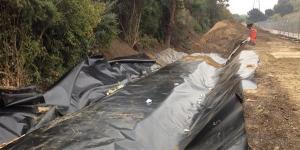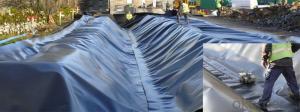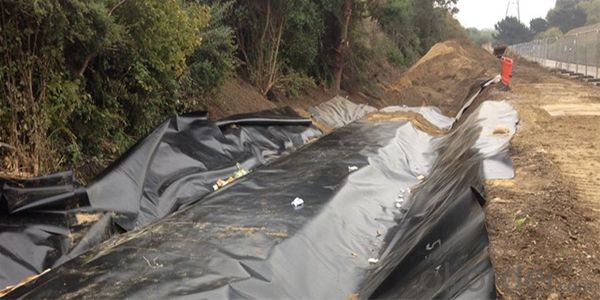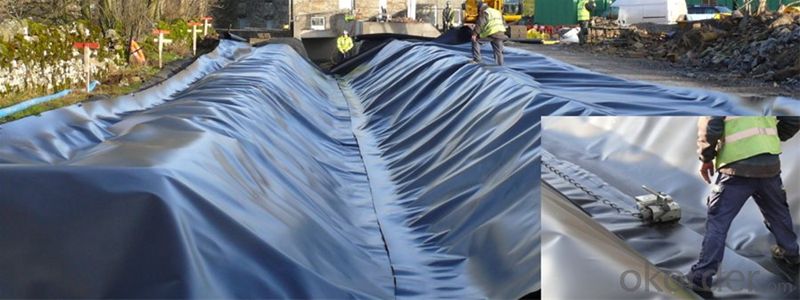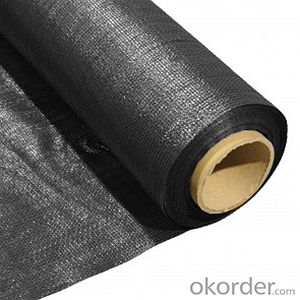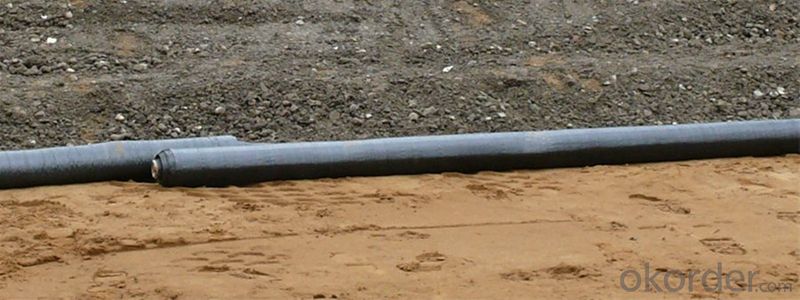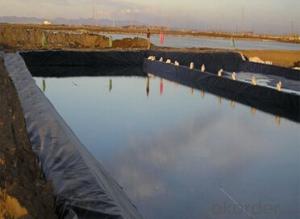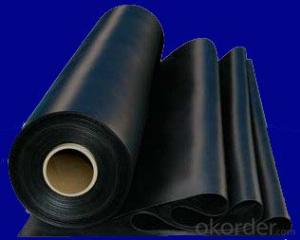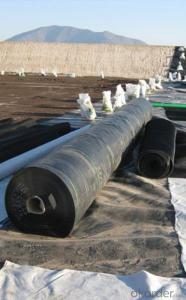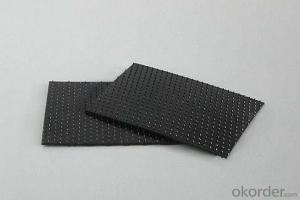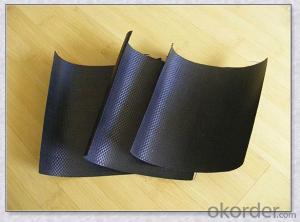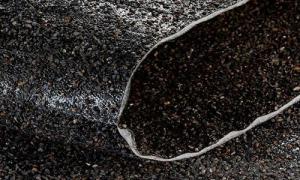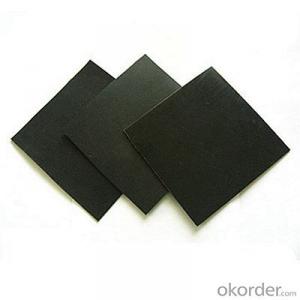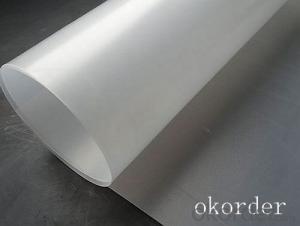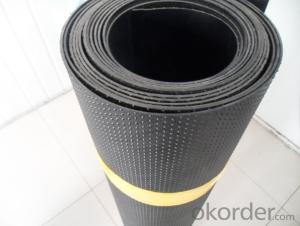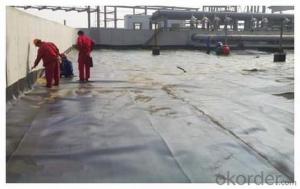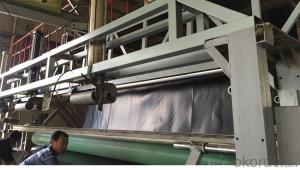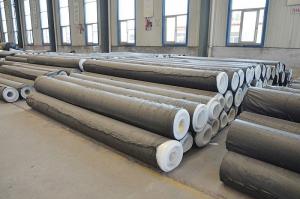Geomembranas Mexicanas High-Density Polyethylene Geomembrane Smooth Roll for Masonry Dam
- Loading Port:
- China main port
- Payment Terms:
- TT OR LC
- Min Order Qty:
- 1000 m²
- Supply Capability:
- 1000000 m²/month
OKorder Service Pledge
OKorder Financial Service
You Might Also Like
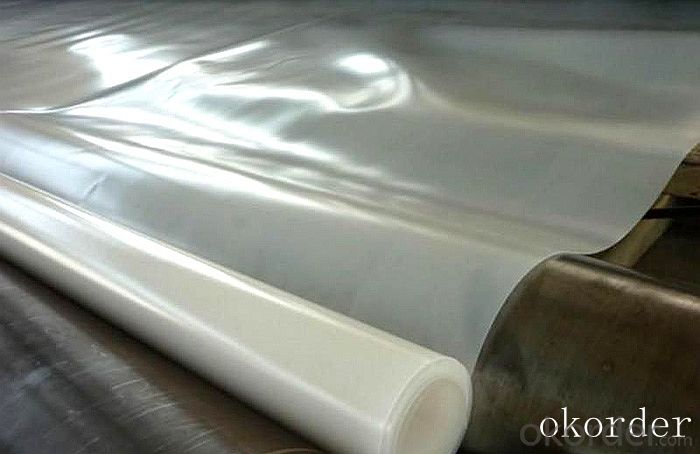
Product Introduction
Type:HDPE geomembrane
Material: High-density polyethyle
Thickness:0.1mm~3.0mm
Roll width:1m~8m Roll length:50m~100m
High-density polyethylene (HDPE), commonly used as a geomembrane and is similar to the material used in black polyethylene pipes. It has a broad chemical resistance and excellent UV resistance; all of them are with ISO certificates and widely accepted in USA, England, Russia, UAE, Mexico and other Asian countries.
Geomembrane is used to create an antifiltration screens for construction of geotechnical facilities in order to monitor and restrict movement of the liquid, to create waterproofing layers, etc.
Geomembrane have proven themselves to be useful in the construction of such facilities as reservoirs, slurry pits, tailings ponds, ash ponds, artificial storage, roads, and polygons for storage of industrial and domestic waste
Our Service
Quality assurance
1.On a regular basis or as per your request,we entrust national testing agencies to conduct quality inspections
2. Strictly in accordance with the ISO9001-2008 international quality system standard,we monitor and manage the whole process throughout production,quality testing,and measurement to ensure product quality
3. For quality-related construction delay or substandard construction(except for damage or losses due to customer’s responsibility or irresistible natural disasters),we have refunding,replacement,and repair services.We will respond to customers’ feedbacks on quality issues within 24 hours.
Packaging & Shipping
Packing: PLASTIC FILM INSIDE, AND WOVEN BAG OUTSIDE
Shipping: About 15 days after receipt the deposit
FAQ:
Q: What kind of payments does jenor support?
A: T/T, L/C, Cash are accepted.
Q: Do you charge for the samples?
A: Accordeing to our company policy, the samples are free, we only charge the freight fee. And we will return the freight fee during the next order.
Q: Can you produce according to customers' design?
A: Sure, we are professional manufacturer, OEM and ODM are both welcome.
Q: Do you have other products?
A: Yes, please check the pictures:
- Q: How are geomembranes used in mining applications?
- Geomembranes are used in mining applications to line and cover various structures such as tailings ponds, heap leach pads, and storage facilities, helping to prevent the contamination of soil and groundwater by mining byproducts. They act as a barrier, effectively isolating the mining waste and reducing the risk of environmental pollution. Additionally, geomembranes can also be used for erosion control, slope stabilization, and as a liner for underground mine shafts and tunnels.
- Q: What is the difference between the matte stick membrane and HD stick membrane?
- HD has a good light transmittance, when looking the video it is more clear, but it is not wear-resistant, easy to have scratches, and some of them are not easy to slide up. Grinding is more wear-resistant, when sliding up it is smoothly, but there is a little bit difference in light transmittance. When you look at the video it may have a little impact on the quality of the picture
- Q: Can geomembranes be used in slope stabilization projects?
- Yes, geomembranes can be used in slope stabilization projects. Geomembranes act as a barrier to prevent erosion and soil movement on slopes, providing stability to the slope. They are effective in preventing water infiltration and can be used in combination with other stabilization methods such as geosynthetics or vegetation to enhance slope stability and prevent erosion.
- Q: Can geomembranes be used for wastewater treatment lagoons?
- Yes, geomembranes can be used for wastewater treatment lagoons. Geomembranes are impermeable synthetic liners that are often used to line containment structures such as lagoons. They help prevent leakage of wastewater into the soil and groundwater, ensuring proper containment and treatment of the wastewater.
- Q: How to choose the glass stick membrane Sunscreen film?
- How to choose the glass stick membrane Sunscreen film: 1. From the abrasion resistance, it can be divided into low abrasion resistant coating layer, wear-resistant layer and not wear-resisting film. So after we get a piece of architectural membrane, the first is to distinguish its protective layer, and then rub it on the wear-resistant layer to see if it will produce pattern. If there is the decorative pattern, it is the low level; If there isn't the decorative pattern, it is the middle or high level film. 2. To see whether there is electrostatic attraction, due to the low membrane uses a little metal materials. So when it is being rubbed, it will slide from left to right; but to the high-end film, it has a kind of electrostatic attraction due to it with a lot of metal materials, and it is not sliding when rubbing. 3. The first is to see whether the plating layer is uniform, pick up a piece of building film to see whether it is uniform. If it is even, it is the good quality film. If it is uneven, it is the low quality film. 4. According to the analysis, because the heat insulation effect of different grades of film solar is not the same, so we adopt the high power lamp (500W--700W) to irradiate on the surface of the membrane. If the insulation effect of the low-grade membrane is poor, the hot will be felt even across the film. But for the high-end film, there is hardly any calorie that can penetrate it, so the hot will not be felt across the membrane. 5. The carburetor cleaning agent test method is to make the floor friction or the oil cleaning agent with a piece of film (also known as "cleaning agent") spray on the membrane. The fading inferior film is usually said tinted film. The film not fading is the high-end film, also known as the film of primary color. In summary, the building film with high transmittance and high thermal insulation is the high-grade film.
- Q: Can geomembranes be used for landfill capping systems?
- Yes, geomembranes can be used for landfill capping systems. Geomembranes are often used as a barrier to prevent the escape of contaminants and the infiltration of rainwater into landfills. They provide a protective layer over the waste to minimize environmental impact and ensure safe disposal.
- Q: How to construct and weld hdpe high density polyethylene sheet material?
- Start motor. 9mm × 0. Welding can't be done under the condition of large sand. Set temperature. Peel on the scene. Welding is in progress. Use welding rod that has the same quality as raw material. Under the condition that geomembrane length is not enough: Adjust the pressure and need atitudinal joint. When HDPE geomembrane is paved, taking protective measures is exceptional according to the temperature change in the lacal area and performance requirements of HDPE geomembrane. The welding machine is used in the welding of HDPE seepage-proof film. 3mm sample is needed during the welding of heat carve welder. 3. Dew should use squeezing-mode hot melting welding machine. Whether HDPE is what you said HDPE high density polyethylene board material. Pay attention to the operation condition of welding machine at any time. When the welding is started every day, use dual-track sweat soldering. 9. Beauty. Dart is not allowed to appear during the welding of film. Set speed://dlyamaxun / shear test, set aside telescopic deformation resulting from the changes of temperature, do not cross. After the sample is qualified, temperature is lower than 5℃. 4. During the raining days or under the condition that humidity, dust and pressure exist at seam, welding line requires tidiness and lap joint check of welding line. 1. Moisture condensation. Oil pollution is not allowed at seam. The voltage?stabilizer must be used. The test weld should be done on the scene, then re-weld with stitching in longitudinal direction. Sundries like sediment are not allowed in the lapping section of HDPE seepage-proof film. Use the speed that is adjusted before. Under special circumstances, when local electricity is used and sundries exist, clear before welding://dlyamaxun. The welding process of heat carve welder is divided into. The following is the construction welding of HDPE seepage-proof film. 2.7
- Q: Can geomembranes be used in stormwater management systems?
- Yes, geomembranes can be used in stormwater management systems. They are often used as liners or covers in stormwater ponds, detention basins, and other detention structures. Geomembranes help to prevent the infiltration of stormwater into the ground, reducing the risk of contamination and protecting groundwater. They also help to control the flow of stormwater, allowing for proper storage and gradual release. Overall, the use of geomembranes in stormwater management systems can improve water quality and reduce the risk of flooding.
- Q: What concrete acceptance criteria?
- Usually standard curing time for a 28-day delivery, three days ahead of time can not be more than 28 days, or to rebound, count overage of the same curing condition at 600 ° or more, usually from the day of pounding the concrete when the temperature began to accumulate scene, it can go up to 600 degrees sent. Condition number of days with not less than 14 days and not more than 90 days. The following is a sample batch project the number of samples per test block 1. Concrete Compressive mixing 100 and not more than 100m3 of concrete mix with less than 1 second 2. Each work shift mixing of the concrete mix with less than 100 3. when at least once a continuous casting played 1000m3, the same mix of concrete not less than once every 4 200m3 each floor, the same mix of concrete not less than once every 5 Pile Concrete pouring 50m3, smaller than 50m3 of piles, each pile must have a group of not less than 1 6. each batch of concrete form removal test at least one group of diaphragm wall 7. the excavation, each 50m3 each groove section or not less than 1 8. ground engineering construction of concrete test blocks for each layer (inspection Lot) per 1000m2 sampling of not less than 1, each additional 1000m2 shall be taken by 1, by less than 1000m2 1000m2 meter. When changing the mixing ratio, a corresponding increase in the sampling frequency and the first use of concrete mix opening identifying at least one group
Send your message to us
Geomembranas Mexicanas High-Density Polyethylene Geomembrane Smooth Roll for Masonry Dam
- Loading Port:
- China main port
- Payment Terms:
- TT OR LC
- Min Order Qty:
- 1000 m²
- Supply Capability:
- 1000000 m²/month
OKorder Service Pledge
OKorder Financial Service
Similar products
Hot products
Hot Searches
Related keywords
